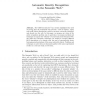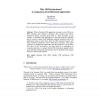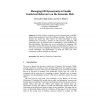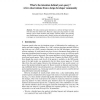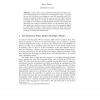ESWS
2008
Springer
14 years 1 months ago
2008
Springer
The OKKAM initiative1 has recently highlighted the need of moving from the traditional web towards a "web of entities", where real-world objects descriptions could be ret...
ESWS
2008
Springer
14 years 1 months ago
2008
Springer
When a Semantic Web application encounters a new URI in an RDF statement, how should it determine what resource that URI is intended to denote, and learn more about it? Since asser...
ESWS
2008
Springer
14 years 1 months ago
2008
Springer
The Web of Data is growing at an ever increasing rate, with RDF datasets being produced in the order of billions of triples. The effect of this increase has meant that many entitie...
ESWS
2008
Springer
14 years 1 months ago
2008
Springer
Abstract. The generation of entity identifiers is a key issue in the context of semantic web technologies. Entity identifiers are needed when we perform any kind of operation (e.g....
ESWS
2008
Springer
14 years 1 months ago
2008
Springer
We study common query intentions in a software developer network with more than one million users. Based on a large query log analysis we could identify typical search intentions a...
ESWS
2008
Springer
14 years 1 months ago
2008
Springer
Abstract. If one wants to have a scheme for identifying non-Web accessible entities, should it be centralized or decentralized? Given a URI, how can one tell if it refers to a web ...
ESWS
2008
Springer
14 years 1 months ago
2008
Springer
Finding RDF individuals that refer to the same real-world entities but have different URIs is necessary for the efficient use of data across sources. The requirements for such inst...
ESWS
2008
Springer
14 years 1 months ago
2008
Springer
Abstract. Geographic place names are semantically often highly ambiguous. For example, there are 491 places in Finland sharing the same name "Isosaari" (great island) tha...
ESWS
2008
Springer
14 years 1 months ago
2008
Springer
In this paper, we examine the special requirements of lifecycle management for entities in the context of an entity management system for the semantic web. We study the requirement...
ESWS
2008
Springer
14 years 1 months ago
2008
Springer
Abstract. The Semantic Web is an effort by the W3C to enable integration and sharing of information across different applications and organizations using annotations by means of on...
